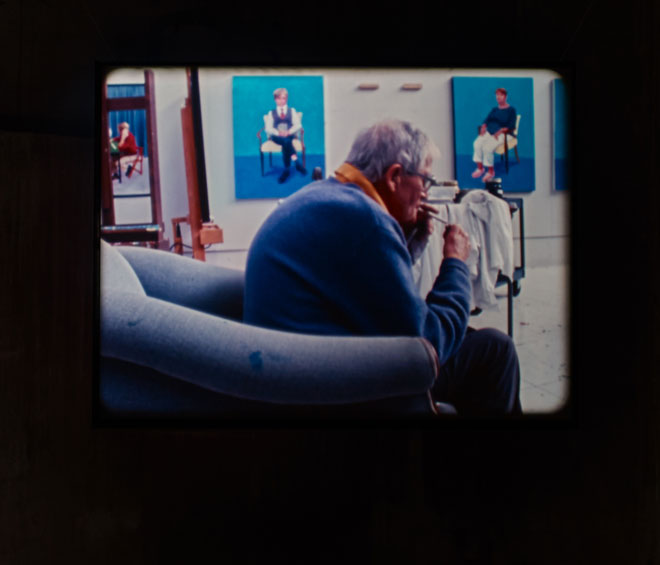
Frith Street Gallery, London
16 September – 4 November 2016
by CASSIE DAVIES
In the opening scene of Tacita Dean’s 2015 film Event for a Stage, artist and actor Stephen Dillane paces the stage as the audience filter into the theatre. He follows the perimeter of the stage, marked by a white chalk circle, cursing under his breath, while the audience take their seats before the start of the performance. He is frustrated and annoyed, it seems, by the cameras focusing in and the audience who are beginning to encircle him. “Too fucking cosy for starters,” he mutters.
Event for a Stage was initially commissioned as a live performance for the 2014 Sydney Biennale, which took place in the City’s Carriageworks over four consecutive nights. Dean, born in Canterbury in 1965, is best known for her 16mm film, drawing and photography. She has received various awards, including the Kurt Schwitters Prize in 2009 and the Hugo Boss Prize in 2006. She has never worked in theatre before the performance at the Sydney Biennale, and the tension between the two disciplines are played out in Event for a Stage. Dean filmed each of the four, 50-minute performances, cutting and editing each night together to make the final film, also 50-minutes long. Her editing is incredibly precise, and the four nights are fluidly brought into one in Dean’s film, with only Dillane’s change of hairstyle and facial hair – short and tied back with a bow, worn loose, bewigged; clean- shaven, bearded – to distinguish between each performance. The film is presented at Frith Street Gallery as part of Dean’s current solo show, LA Exuberance.
It is unclear how rehearsed Dillane’s performances are or, for that matter, how authentic they are. Structure is provided by Dean, who sits in the audience, handing Dillane sheets of script, which he takes, unwillingly, and reads out loud. The scripts are all centred on acting and the artifice of theatre; the spectacle of performance, the separation between actor and audience, the status of the actor. Dillane reads with emotional intensity, switching between sarcasm, anger, laughter and sadness. “Without the separation, the spectacle would become life”; “Art is what makes life more interesting than art”; “A good life is a life well played”; “An actor is the lowest form of life; I have no will of my own.” The element of unpredictability – both in what is written/unwritten on the script and in Dillane’s emotional reaction to it – is absorbing and startling.
After finishing with each script, Dillane discards the sheet and lets it drift to the floor of the stage, before continuing with the other side of his performance – that is, the story of his relationship with his parents. He speaks of their descent into dementia, his father’s death and cremation in Brighton, the funeral and, towards the end of the film, the sudden, tragic death of his brother. The chalk circle separates story and script; Dillane paces the outer perimeter of the circle as he tells the story of his parents, before taking a script from Dean in the audience and returning to the circle’s centre to perform it. The chalk circle is an important prop (if it can be called that), playing out the various, antagonistic pairings that Event for a Stage performs for its audience, such as that between acting and real life, stage and audience, film and theatre and, last, between Dean and Dillane.
Presented alongside Event for a Stage is LA Exuberance, a collection of new lithographs that document Dean’s time spent in Los Angeles, where she had been invited as artist in residence at the Getty Research Institute 2014-15. Dean worked with Gemini GEL, an esteemed print publisher in Los Angeles, to produce a set of colour lithographs, capturing the graceful clouds and vapour trails in the city that caught her attention. The drawings are not to be mistaken for photographs, although their beautiful simplicity adheres to a photographic quality. Shown in conjunction with the artist’s lithographs are a series of slate drawings that continue Dean’s documentation of clouds, this time captured using spray chalk, gouache and white charcoal pencil. Delicately drawn over the slates are sets of gridded lines, locking the drifting clouds into a formal structure.
On show downstairs at Frith Street Gallery is another of Dean’s 16mm films, Portraits (2016). The film was made while Dean was in Los Angeles, where she had the chance to meet David Hockney. In the film, Hockney smokes in an armchair in his studio, surrounded by portraits that are now on show in the Sackler Galleries at the Royal Academy in London. The film is a layering of portraits, from the moving image of Hockney in his studio to his paintings that hang on the wall behind him, which includes, one of Dean’s son Rufus. In the space of 16 minutes (the length of Portraits), Hockney smokes five cigarettes – smoking is, it must be noted, intrinsic to Hockey’s artistic process and concentration. He sits comfortably, silently, for Dean, seemingly unaware of the camera’s gaze.
The basement room at Frith Street Gallery is silent, too, aside from the reeling projector, before Hockney unexpectedly erupts into laughter. At Dean? At himself? Or nothing at all? The sound of his laughter can be heard from the upper gallery, where Event for a Stage plays in a separate room and where, at the front of the gallery, people observe Dean’s series of lithographs and slate drawings. Hockney’s laugh is still startling even when it is rooms apart, a response not dissimilar to that which parts of Dillane’s performance elicit in Event for a Stage. Whether scripted or not, the bursts of emotion in these two films are entirely engaging. It is a spontaneity that also lies in the intricate degree of Dean’s technical skill and her exceptional ability, through drawing, filming and editing, to capture something fleeting, from the turns and throes of emotion, to the drifting clouds in Los Angeles.